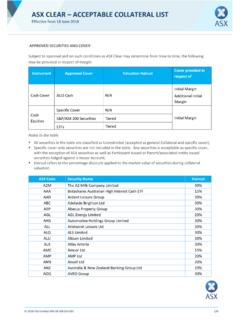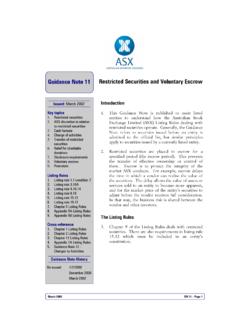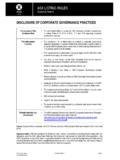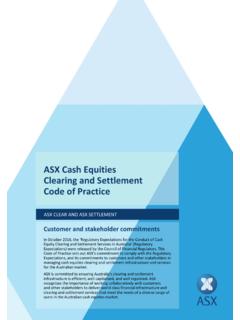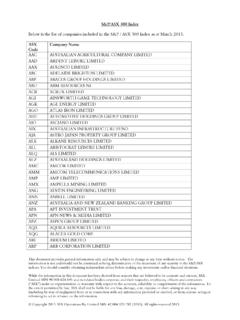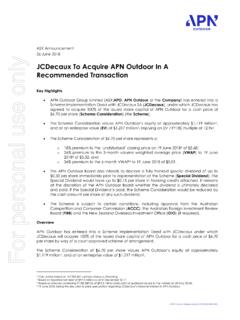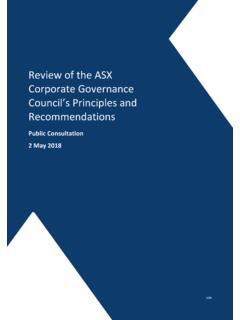Transcription of Corporate Governance Principles and Recommendations - …
1 Corporate Governance Principles and Recommendations4th EditionFebruary 2019 ASX Corporate Governance CouncilLay solid foundations for management and oversight: A listed entity should clearly delineate the respective roles and responsibilities of its board and management and regularly review their performance. Structure the board to be effective and add value: The board of a listed entity should be of an appropriate size and collectively have the skills, commitment and knowledge of the entity and the industry in which it operates, to enable it to discharge its duties effectively and to add value. Instil a culture of acting lawfully, ethically and responsibly: A listed entity should instil and continually reinforce a culture across the organisation of acting lawfully, ethically and responsibly. Safeguard the integrity of Corporate reports: A listed entity should have appropriate processes to verify the integrity of its Corporate reports. Make timely and balanced disclosure: A listed entity should make timely and balanced disclosure of all matters concerning it that a reasonable person would expect to have a material effect on the price or value of its securities.
2 Respect the rights of security holders: A listed entity should provide its security holders with appropriate information and facilities to allow them to exercise their rights as security holders effectively. Recognise and manage risk: A listed entity should establish a sound risk management framework and periodically review the effectiveness of that framework. Remunerate fairly and responsibly: A listed entity should pay director remuneration sufficient to attract and retain high quality directors and design its executive remuneration to attract, retain and motivate high quality senior executives and to align their interests with the creation of value for security holders and with the entity s values and risk 8 Principles12345678 ContentsForeword ..1 About the Council ..1 What is Corporate Governance ? ..1 The purpose of the Principles and Recommendations ..1 The basis of the Principles and Recommendations the if not, why not approach .. 2 The application of the Principles and Recommendations .
3 2 The structure of the Principles and Recommendations .. 2 The linkage with ASX s listing rules .. 3 Where to make Corporate Governance disclosures .. 3 How to approach Corporate Governance disclosures .. 4 Disclosing the fact that a recommendation is followed .. 4 Disclosing the reasons for not following a recommendation .. 4 Effective date .. 5 Acknowledgments .. 5 Principle 1 / Lay solid foundations for management and oversight .. 6 Principle 2 / Structure the board to be effective and add value .. 12 Principle 3 / Instil a culture of acting lawfully, ethically and responsibly .. 16 Principle 4 / Safeguard the integrity of Corporate reports .. 19 Principle 5 / Make timely and balanced disclosure .. 21 Principle 6 / Respect the rights of security holders .. 23 Principle 7 / Recognise and manage risk .. 26 Principle 8 / Remunerate fairly and responsibly .. 29 Additional Recommendations that apply only in certain cases .. 32 The application of the Recommendations to externally managed listed entities.
4 33 Glossary .. 351 / Corporate Governance Principles and Recommendations 4th Edition 2019 About the CouncilThe Council was convened in August 2002. It brings together various business, shareholder and industry groups, each offering valuable insights and expertise on Governance issues from the perspective of their particular stakeholders. Its primary work has been the development of the Principles and members of the Council are: Association of Superannuation Funds of Australia Limited ASX Limited Australasian Investor Relations Association Australian Council of Superannuation Investors Australian Institute of Company Directors Australian Institute of Superannuation Trustees Australian Shareholders Association Business Council of Australia Chartered Accountants Australia and New Zealand CPA Australia Ltd Financial Services Council Financial Services Institute of Australasia Governance Institute of Australia Group of 100 Institute of Internal Auditors - Australia Institute of Public Accountants Law Council of Australia Property Council of Australia Stockbrokers and Financial Advisers Association LimitedFurther information about the Council, including a copy of its charter, is available at.
5 Justice Owen in the HIH Royal Commission, The Failure of HIH Insurance Volume 1: A Corporate Collapse and Its Lessons, Commonwealth of Australia, April 2003 at page is Corporate Governance ?The phrase Corporate Governance describes the framework of rules, relationships, systems and processes within and by which authority is exercised and controlled within corporations. It encompasses the mechanisms by which companies, and those in control, are held to account. 1 Good Corporate Governance promotes investor confidence, which is crucial to the ability of entities listed on the ASX to compete for purpose of the Principles and RecommendationsThese Principles and Recommendations set out recommended Corporate Governance practices for entities listed on the ASX that, in the Council s view, are likely to achieve good Governance outcomes and meet the reasonable expectations of most investors in most Council recognises, however, that different entities may legitimately adopt different Governance practices, based on a range of factors, including their size, complexity, history and Corporate culture.
6 For that reason, the Principles and Recommendations are not mandatory and do not seek to prescribe the Corporate Governance practices that a listed entity must adopt. ForewordThe Corporate Governance Principles and Recommendations ( Principles and Recommendations ) were first introduced in 2003. A second edition was published in 2007 and a third in 2017, the ASX Corporate Governance Council ( Council ) agreed that it was an appropriate time to commence work on a fourth edition of the Principles and Recommendations to address emerging issues around culture, values and trust, fuelled by recent examples of conduct by some listed entities falling short of community standards and expectations. The fourth edition comes into force for financial years commencing on or after 1 January would like to express my appreciation to the Council for its work in maintaining the Principles and Recommendations as a world-leading standard on Corporate Governance by listed Johnstone, Chair, ASX Corporate Governance CouncilASX Corporate Governance Council / 2 Lay solid foundations for management and oversight: A listed entity should clearly delineate the respective roles and responsibilities of its board and management and regularly review their performance.
7 Structure the board to be effective and add value: The board of a listed entity should be of an appropriate size and collectively have the skills, commitment and knowledge of the entity and the industry in which it operates, to enable it to discharge its duties effectively and to add value. Instil a culture of acting lawfully, ethically and responsibly: A listed entity should instil and continually reinforce a culture across the organisation of acting lawfully, ethically and responsibly. Safeguard the integrity of Corporate reports: A listed entity should have appropriate processes to verify the integrity of its Corporate reports. Make timely and balanced disclosure: A listed entity should make timely and balanced disclosure of all matters concerning it that a reasonable person would expect to have a material effect on the price or value of its securities. Respect the rights of security holders: A listed entity should provide its security holders with appropriate information and facilities to allow them to exercise their rights as security holders effectively.
8 Recognise and manage risk: A listed entity should establish a sound risk management framework and periodically review the effectiveness of that framework. Remunerate fairly and responsibly: A listed entity should pay director remuneration sufficient to attract and retain high quality directors and design its executive remuneration to attract, retain and motivate high quality senior executives and to align their interests with the creation of value for security holders and with the entity s values and risk basis of the Principles and Recommendations the if not, why not approachWhich Governance practices a listed entity chooses to adopt is fundamentally a matter for its board of directors, the body charged with the legal responsibility for managing its business with due care and diligence2 and therefore for ensuring that it has appropriate Governance arrangements in the Principles and Recommendations , if the board of a listed entity considers that a Council recommendation is not appropriate to its particular circumstances, it is entitled not to adopt it.
9 If it does so, however, it must explain why it has not adopted the recommendation the if not, why not approach ensures that the market receives an appropriate level of information about the entity s Governance arrangements so that investors and other stakeholders can have a meaningful dialogue with the board and management on Governance matters and can factor the information provided into their decision on whether or not to invest in the entity and how to vote on particular if not, why not approach is fundamental to the operation of the Principles and application of the Principles and RecommendationsThe Principles and Recommendations apply to all entities admitted to the ASX official list as an ASX listing,3 regardless of the legal form they take,4 whether they are established in Australia or elsewhere, and whether they are internally or externally Principles and Recommendations are specifically directed at, and only intended to apply to, ASX listed entities.
10 However, as they reflect a contemporary view of appropriate Corporate Governance standards, other bodies may find them helpful in formulating their Governance rules or Sections 180 (in the case of a listed company) and 601FD(1)(b) (in the case of a listed trust) of the Corporations The Principles and Recommendations do not apply to entities admitted to the ASX official list as ASX debt listings or ASX foreign exempt That is, whether they are a listed company, listed trust or listed stapled structure of the Principles and RecommendationsThe Principles and Recommendations are structured around, and seek to promote, 8 central Principles :3 / Corporate Governance Principles and Recommendations 4th Edition 2019 There are 35 specific Recommendations of general application intended to give effect to these Principles , as well as 3 additional Recommendations that only apply in certain limited cases. These additional Recommendations are included in the third last section of this document, immediately after the section dealing with principle is also explanatory commentary with further guidance on the Recommendations require modification when applied to externally managed listed entities.
